
leads4pass has released a new Fortinet NSE8_812 dumps update and shared the latest exam questions and answers in Fortinetexamdumps!
Download Fortinet NSE8_812 dumps with PDF and VCE: https://www.leads4pass.com/nse8_812.html Contains 60 latest and valid exam questions and answers to help you easily pass the NSE8_812 “Network Security Expert 8 Written” Exam!
Bonus! Practice the latest Fortinet NSE8_812 dumps exam questions online
| From | Number of exam questions | Type | Related exams |
| leads4pass | 15 | Free | NSE 8 Network Security Expert |
Question 1:
An automation stitch was configured using an incoming webhook as the trigger named \’my_incoming_webhook\’. The action is configured to execute the CLI Script shown:
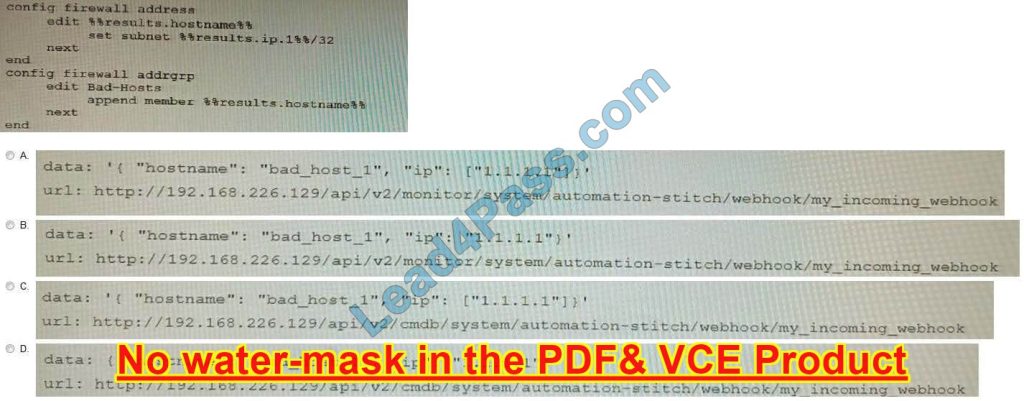
A. Option A
B. Option B
C. Option C
D. Option D
Correct Answer: A
Explanation: The CLI script in option A will send the log message to the webhook server. The webhook server can then be configured to take any desired action, such as storing the log message in a database or sending an email notification.
The other options are incorrect. Option B will not send the log message to the webhook server because it does not contain the curl command.
Option C will send the log message to the webhook server, but it will also include the FortiGate\’s IP address and MAC address.
This information is not necessary, and it could be used by an attacker to identify the FortiGate. Option D will not send the log message to the webhook server because it does not contain the webhook action.
References:
Automation webhook stitches:
https://docs.fortinet.com/document/fortigate/7.4.0/administration-guide/989735/webhook-action
Webhooks: https://en.wikipedia.org/wiki/Webhook
Question 2:
Refer to the exhibit.

FortiManager is configured with the Jinja Script under CLI Templates shown in the exhibit.
Which two statements correctly describe the expected behavior when running this template? (Choose two.)
A. The Jinja template will automatically map the interface with the “WAN” role on the managed FortiGate.
B. The template will work if you change the variable format to $(WAN).
C. The template will work if you change the variable format to {{ WAN }}.
D. The administrator must first manually map the interface for each device with a meta field.
E. The template will fail because this configuration can only be applied with a CLI or TCL script.
Correct Answer: DE
Explanation: D. The administrator must first manually map the interface for each device with a meta field.
The Jinja template in the exhibit expects a meta field called WAN to be set on the managed FortiGate. This meta field will specify which interface on the FortiGate should be assigned the “WAN” role. If the meta field is not set, then the template will fail. E. The template will fail because this configuration can only be applied with a CLI or TCL script.
The Jinja template in the exhibit is trying to configure the interface role on the managed FortiGate. This type of configuration can only be applied with a CLI or TCL script. The Jinja template will fail because it is not a valid CLI or TCL script.
Question 3:
Refer to the exhibit.

You have been tasked with replacing the managed switch Forti Switch 2 shown in the topology. Which two actions are correct regarding the replacement process? (Choose two.)
A. After replacing the FortiSwitch unit, the automatically created trunk name does not change
B. CLAG-ICL needs to be manually reconfigured once the new switch is connected to the FortiGate
C. After replacing the FortiSwitch unit, the automatically created trunk name changes.
D. MCLAG-ICL will be automatically reconfigured once the new switch is connected to the FortiGate.
Correct Answer: AB
A is correct because the automatically created trunk name is based on the MAC address of the FortiSwitch unit. When the FortiSwitch unit is replaced, the MAC address will change, but the trunk name will not change.
B is correct because CLAG-ICL is a manually configured link aggregation group. When the FortiSwitch unit is replaced, the CLAG-ICL configuration will need to be manually reconfigured on the new FortiSwitch unit. The other options are incorrect.
Option C is incorrect because the automatically created trunk name does not change when the FortiSwitch unit is replaced.
Option D is incorrect because MCLAG-ICL is a manually configured link aggregation group and will not be automatically reconfigured when the FortiSwitch unit is replaced.
References: Configuring link aggregation on FortiSwitches | FortiSwitch / FortiOS 7.0.4 – Fortinet Document Library Managing FortiLink | FortiGate / FortiOS 7.0.4 – Fortinet Document Library
Question 4:
Refer to the exhibits.

The exhibits show a diagram of a requested topology and the base IPsec configuration.
A customer asks you to configure ADVPN via two internet underlays. The requirement is that you use one interface with a single IP address on DC FortiGate.
In this scenario, which feature should be implemented to achieve this requirement?
A. Use network-overlay id
B. Change advpn2 to IKEv1
C. Use local-id
D. Use peer-id
Correct Answer: A
Explanation: A is correct because using network-overlay ID allows you to configure multiple ADVPN tunnels on a single interface with a single IP address on the DC FortiGate.
This is explained in the FortiGate Administration Guide under ADVPN > Configuring ADVPN > Configuring ADVPN on the hub.
References: https://docs.fortinet.com/document/fortigate/7.4.0/administration-guide/978793/advpn https://docs.fortinet.com/document/fortigate/7.4.0/administration-guide/978793/advpn/978794/configuring-advpn
Question 5:
Refer to the exhibits.
Exhibit A

Exhibit B
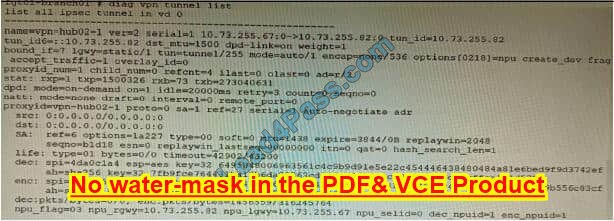
Exhibit C
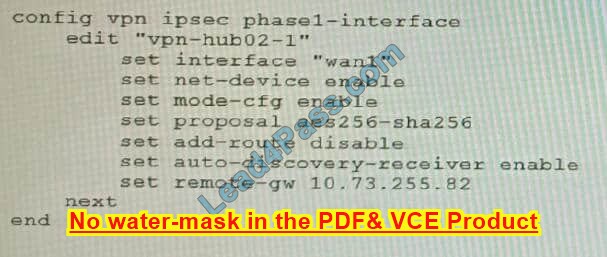
A customer is trying to set up a VPN with a FortiGate, but they do not have a backup of the configuration. Output during a troubleshooting session is shown in Exhibits A and B and a baseline VPN configuration is shown in Exhibit C Referring to the exhibits, which configuration will restore VPN connectivity?

A. Option A
B. Option B
C. Option C
D. Option D
Correct Answer: C
Explanation: The output in Exhibit A shows that the VPN tunnel is not established because the peer IP address is incorrect.
The output in Exhibit B shows that the peer IP address is 192.168.1.100, but the baseline VPN configuration in Exhibit C shows that the peer IP address should be 192.168.1.101. To restore VPN connectivity, you need to change the peer IP address in the VPN tunnel configuration to 192.168.1.101.
The correct configuration is shown below: config vpn ipsec phase1-interface edit “wan” set peer-ip 192.168.1.101 set peer-id 192.168.1.101 set dhgrp 1 set auth-mode psk set psk SECRET_PSK next end Option A is incorrect because it does not change the peer IP address.
Option B is incorrect because it changes the peer IP address to 192.168.1.100, which is the incorrect IP address. Option D is incorrect because it does not include the necessary configuration for the VPN tunnel.
Question 6:
You must analyze an event that happened at 20:37 UTC. One log relevant to the event is extracted from FortiGate logs:

The devices and the administrator are all located in different time zones Daylight savings time (DST) is disabled The FortiGate is at GMT-1000. The FortiAnalyzer is at GMT-0800 Your browser’s local time zone is GMT-03.00
You want to review this log on FortiAnalyzer GUI, what time should you use it as a filter?
A. 20:37:08
B. 10:37:08
C. 17:37:08
D. 12.37:08
Correct Answer: C
Explanation: To review this log on FortiAnalyzer GUI, the administrator should use the time filter that matches the local time zone of FortiAnalyzer, which is GMT-0800.
Since the log was generated at 20:37 UTC (GMT+0000), the corresponding time in GMT-0800 is 20:37 – 8 hours = 12:37.
However, since DST is disabled on FortiAnalyzer, the administrator should add one hour to account for the daylight saving time difference, resulting in 12:37 + 1 hour = 13:37. Therefore, the time filter to use is 13:37:08.
Question 7:
Refer to the exhibits.

An administrator has configured a FortiGate and Forti Authenticator for two-factor authentication with FortiToken push notifications for their SSL VPN login.
Upon initial review of the setup, the administrator has discovered that the customers can manually type in their two-factor code and authenticate but push notifications do not work Based on the information given in the exhibits, what must be done to fix this?
A. On FG-1 port1, the FTP access protocol must be enabled.
B. FAC-1 must have an internet-routable IP address for push notifications.
C. On FG-1 CLI, the FTP-push server setting must point to 100.64.141.
D. On FAC-1, the FortiToken public IP setting must point to 100.64.1 41
Correct Answer: B
Explanation: FortiToken push notifications require that the FortiAuthenticator has an internet-routable IP address. This is because the FortiAuthenticator uses this IP address to send push notifications to the FortiGate.
The other options are not correct. Enabling the FTP access protocol on FG-1 port1 is not necessary for push notifications to work. The ftm-push server setting on FG-1 CLI should already point to the FortiAuthenticator\’s IP address. The FortiToken public IP setting on FAC-1 is not relevant to push notifications.
Here is a table that summarizes the different options:

Question 8:
Refer to the exhibit.

You are operating an internal network with multiple OSPF routers on the same LAN segment. FGT_3 needs to be added to the OSPF network and has the configuration shown in the exhibit.
FGT_3 is not establishing any OSPF connection.
What needs to be changed to the configuration to make sure FGT_3 will establish OSPF neighbors without affecting the DR/BDR election?
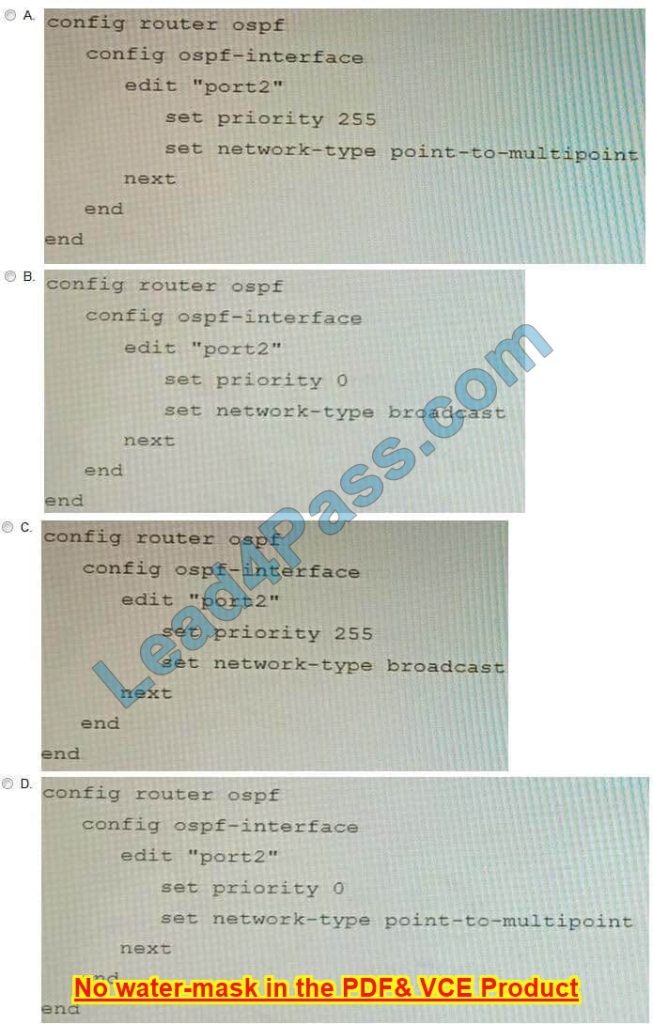
A. Option A
B. Option B
C. Option C
D. Option D
Correct Answer: B
Explanation: The OSPF configuration shown in the exhibit is using the default priority value of 1 for the interface port1.
This means that FGT_3 will participate in the DR/BDR election process with the other OSPF routers on the same LAN segment. However, this is not desirable because FGT_3 is a new device that needs to be added to the OSPF network without affecting the existing DR/BDR election.
Therefore, to make sure FGT_3 will establish OSPF neighbors without affecting the DR/BDR election, the priority value of the interface port1 should be changed to 0.
This will prevent FGT_3 from becoming a DR or BDR and allow it to form OSPF adjacencies with the current DR and BDR.
Option B shows the correct configuration that changes the priority value to 0. Option A is incorrect because it does not change the priority value.
Option C is incorrect because it changes the network type to point-to-point, which is not suitable for a LAN segment with multiple OSPF routers.
Option D is incorrect because it changes the area ID to 0.0.0.1, which does not match the area ID of the other OSPF routers on the same LAN segment.
References:https://docs.fortinet.com/document/ fortigate/7.0.0/administration- guide/358640/basic-ospf-example
Question 9:
Refer to the exhibit showing a FortiSOAR playbook.

You are investigating a suspicious e-mail alert on FortiSOAR, and after reviewing the executed playbook, you can see that it requires intervention.
What should be your next step?
A. Go to the Incident Response tasks dashboard and run the pending actions
B. Click on the notification icon on FortiSOAR GUI and run the pending input action
C. Run the Mark Drive by Download playbook action
D. Reply to the e-mail with the requested Playbook action
Correct Answer: A
Explanation: The exhibited playbook requires intervention, which means that the playbook has reached a point where it needs a human operator to take action.
The next step should be to go to the Incident Response tasks dashboard and run the pending actions. This will allow you to see the pending actions that need to be taken and to take those actions.
The other options are not correct. Option B will only show you the notification icon, but it will not allow you to run the pending input action.
Option C will run the Mark Drive by Download playbook action, but this is not the correct action to take in this case. Option D is not a valid option.
Here are some additional details about pending actions in FortiSOAR:
Pending actions are actions that need to be taken by a human operator. Pending actions are displayed in the Incident Response tasks dashboard. Pending actions can be run by clicking on the action in the dashboard.
Question 10:
A retail customer with a FortiADC HA cluster load balancing five web servers in L7 Full NAT mode is receiving reports of users not being able to access their website during a sale event. But for clients that were able to connect, the website works fine.
CPU usage on the FortiADC and the web servers is low, application and database servers are still able to handle more traffic, and the bandwidth utilization is under 30%.
Which two options can resolve this situation? (Choose two.)
A. Change the persistence rule to LB_PERSIS_SSL_SESSJD.
B. Add more web servers to the real server poof
C. Disable SSL between the FortiADC and the web servers
D. Add a connection pool to the FortiADC virtual server
Correct Answer: BD
Option B: Adding more web servers to the real server pool will increase the overall capacity of the load balancer, which should help resolve the issue of users not being able to access the website.
Option D: Adding a connection pool to the FortiADC virtual server will allow the load balancer to cache connections to the web servers, which can help to improve performance and reduce the number of dropped connections.
Option A:
Changing the persistence rule to LB_PERSIS_SSL_SESSJD would only be necessary if the current persistence rule is not working properly. In this case, the CPU usage on the FortiADC and the web servers is low, so the persistence rule is likely not the issue.
Option C: Disabling SSL between the FortiADC and the web servers would reduce the load on the FortiADC, but it would also make the website less secure. Since the bandwidth utilization is under 30%, it is unlikely that disabling SSL would resolve the issue.
Reference: https://docs.fortinet.com/document/fortiadc/7.2.1/handbook/970956/configuring- virtual-servers
Question 11:
You are responsible for recommending an adapter type for NICs on a FortiGate VM that will run on an ESXi Hypervisor. Your recommendation must consider performance as the main concern, cost is not a factor. Which adapter type for the NICs will you recommend?
A. Native ESXi Networking with E1000
B. Virtual Function (VF) PCI Passthrough
C. Native ESXi Networking with VMXNET3
D. Physical Function (PF) PCI Passthrough
Correct Answer: C
Explanation: The FortiGate VM is a virtual firewall appliance that can run on various hypervisors, such as ESXi, Hyper-V, KVM, etc.
The adapter type for NICs on a FortiGate VM determines the performance and compatibility of the network interface cards with the hypervisor and the physical network.
There are different adapter types available for NICs on a FortiGate VM, such as E1000, VMXNET3, SR-IOV, etc. If performance is the main concern and cost is not a factor, one option is to use native ESXi networking with VMXNET3 adapter type for NICs on a FortiGate VM that will run on an ESXi hypervisor.
VMXNET3 is a para-virtualized network interface card that is optimized for performance in virtual machines and supports features such as multi-queue support, Receive Side Scaling (RSS), Large Receive Offload (LRO), IPv6 offloads, and MSI/MSI-X interrupt delivery.
Native ESXi networking means that the FortiGate VM uses the standard virtual switch (vSwitch) or distributed virtual switch (dvSwitch) provided by the ESXi hypervisor to connect to the physical network.
This option can provide high performance and compatibility for NICs on a FortiGate VM without requiring additional hardware or software components.
https://docs.fortinet.com/document/fortigate/7.0.0/vm-installationfor-vmware- esxi/19662/networking
Question 12:
You are troubleshooting a FortiMail Cloud service integrated with Office 365 where outgoing emails are not reaching the recipients\’ mail What are two possible reasons for this problem? (Choose two.)
A. The FortiMail access control rule to relay from Office 365 servers FQDN is missing.
B. The FortiMail DKIM key was not set using the Auto Generation option.
C. The FortiMail access control rules to relay from Office 365 servers public IPs are missing.
D. A Mail Flow connector from the Exchange Admin Center has not been set properly to the FortiMail Cloud FQDN.
Correct Answer: AD
Explanation: A. The FortiMail access control rule to relay from Office 365 servers FQDN is missing.
If the access control rule to relay from Office 365 servers FQDN is missing, then FortiMail will not be able to send emails to Office 365.
This is because the access control rule specifies which IP addresses or domains are allowed to relay emails through FortiMail. D. A Mail Flow connector from the Exchange Admin Center has not been set properly to the FortiMail Cloud FQDN.
If the Mail Flow connector from the Exchange Admin Center is not set properly to the FortiMail Cloud FQDN, then Office 365 will not be able to send emails to FortiMail. This is because the Mail Flow connector specifies which SMTP server is used to send emails to external recipients.
Question 13:
You want to use the MTA adapter feature on FortiSandbox in an HA-Cluster. Which statement about this solution is true?
A. The configuration of the MTA Adapter Local Interface is different than on port1.
B. The MTA adapter is only available in the primary node.
C. The MTA adapter mode is only a detection mode.
D. The configuration is different than on a standalone device.
Correct Answer: B
Explanation: The MTA adapter feature on FortiSandbox is a feature that allows FortiSandbox to act as a mail transfer agent (MTA) that can receive, inspect, and forward email messages from external sources.
The MTA adapter feature can be used to integrate FortiSandbox with third-party email security solutions that do not support direct integration with FortiSandbox, such as Microsoft Exchange Server or Cisco Email Security Appliance (ESA).
The MTA adapter feature can also be used to enhance email security by adding an additional layer of inspection and filtering before delivering email messages to the final destination.
The MTA adapter feature can be enabled on FortiSandbox in an HA-Cluster, which is a configuration that allows two FortiSandbox units to synchronize their settings and data and provide high availability and load balancing for sandboxing services.
However, one statement about this solution that is true is that the MTA adapter is only available in the primary node.
This means that only one FortiSandbox unit in the HA- Cluster can act as an MTA and receive email messages from external sources, while the other unit acts as a backup node that can take over the MTA role if the primary node fails or loses connectivity.
This also means that only one IP address or FQDN can be used to configure the external sources to send email messages to the FortiSandbox MTA, which is the IP address or FQDN of the primary node.
References: https://docs.fortinet.com/document/fortisandbox/3.2.0/administration-guide/19662/mail- transfer-agent-mta
Question 14:
An HA topology is using the following configuration:

Based on this configuration, how long will it take for a failover to be detected by the secondary cluster member?
A. 600ms
B. 200ms
C. 300ms
D. 100ms
Correct Answer: B
Explanation: The HA heartbeat interval is 100, and the number of lost heartbeats before a failover is detected is 2. So, it will take 2 * 100ms = 200ms for a failover to be detected by the secondary cluster member.
Reference:
FortiGate High Availability:
Question 15:
You are creating the CLI script to be used on a new SD-WAN deployment You will have branches with a different number of internet connections and want to be sure there is no need to change the Performance SLA configuration in case more connections are added to the branch.
The current configuration is:
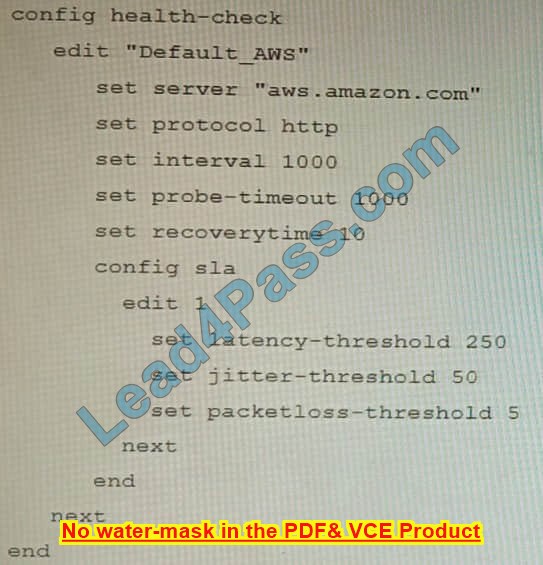
Which configuration do you use for the Performance SLA members?
A. set members any
B. set members 0
C. current configuration already fulfills the requirement
D. set members all
Correct Answer: A
Explanation: The set members of any option will ensure that all of the SD-WAN interfaces are included in the Performance SLA.
This is the best option if you want to be sure that the Performance SLA will be triggered even if more connections are added to the branch in the future.
The set members 0 option will exclude all of the SD-WAN interfaces from the Performance SLA. This is not a good option because it will prevent the Performance SLA from being triggered even if there is a problem with the network.
The current configuration that already fulfills the requirement option is incorrect because it does not ensure that all of the SD-WAN interfaces will be included in the Performance SLA.
The set members all option will include all of the SD-WAN interfaces in the Performance SLA, but it is not the best option because it is not scalable.
If you have a large number of SD-WAN interfaces, this option will cause the Performance SLA to be triggered too often. References: Performance SLA | FortiGate / FortiOS 7.4.0 Configuring Performance SLA | FortiGate / FortiOS 7.4.0
…
leads4pass Fortinet NSE8_812 dumps updated with 60 latest exam questions and answers, now available! Fortinet NSE8_812 dumps PDF and Fortinet NSE8_812 dumps VCE
They all contain complete examination questions, which are researched and reviewed by a professional team and fully comply with the requirements of the NSE8_812 “Network Security Expert 8 Written” Exam! You are guaranteed to pass the exam successfully.
Discover more from Share Fortinet dumps questions online (NSE4,NSE5,NSE6,NSE7,NSE8)
Subscribe to get the latest posts sent to your email.